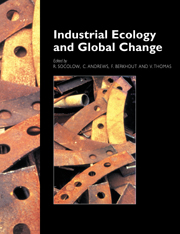Book contents
- Frontmatter
- Contents
- Foreword
- Preface
- Acknowledgments
- Contributors
- OVERVIEW
- 1 Six Perspectives from Industrial Ecology
- PART 1 VULNERABILITY AND ADAPTATION
- PART 2 THE GRAND CYCLES: DISRUPTION AND REPAIR
- PART 3 TOXICS AND THE ENVIRONMENT
- PART 4 INDUSTRIAL ECOLOGY IN FIRMS
- PART 5 INDUSTRIAL ECOLOGY IN POLICY-MAKING
- END PIECE
- Organizing Committee Members
- Working Groups
- Index
1 - Six Perspectives from Industrial Ecology
Published online by Cambridge University Press: 04 August 2010
- Frontmatter
- Contents
- Foreword
- Preface
- Acknowledgments
- Contributors
- OVERVIEW
- 1 Six Perspectives from Industrial Ecology
- PART 1 VULNERABILITY AND ADAPTATION
- PART 2 THE GRAND CYCLES: DISRUPTION AND REPAIR
- PART 3 TOXICS AND THE ENVIRONMENT
- PART 4 INDUSTRIAL ECOLOGY IN FIRMS
- PART 5 INDUSTRIAL ECOLOGY IN POLICY-MAKING
- END PIECE
- Organizing Committee Members
- Working Groups
- Index
Summary
Exploring Industrial Ecology
People are great rearrangers of the earth. Metals that have been locked away in the veins of rocks over the eons of prehistory are mined, freed from their oxide or sulfide drabness, and allowed to shine or cut or channel electrons for our pleasure, for a few decades at most, before being dispersed without plan in soils and streams. Porous sediments more than a kilometer below ground, soaked with oil or laden with natural gas, are penetrated by drill holes to release their burnable contents; people are provided mobility or comfort for a brief moment by the energy accompanying the oxidation of these fuels, and in less than a century the global atmosphere registers five molecules of carbon dioxide for every four that were there before. Chemicals that never existed in the history of our planet are synthesized for the killing of weeds or insects, or for the cooling of transformers. Radioactive isotopes that had decayed to oblivion early in our planet's history are recreated, as the fission of uranium provides another source of electricity and heat. Industrial ecology is a metaphor for looking at our civilization through such lenses.
The metaphor of industrial ecology also leads us to look at interrelationships. The interrelationships among producers and consumers determine what becomes waste and what is usable, and how the “natural” is combined with the “synthetic.” Industrial ecology explores reconfigurations of industrial activity in response to knowledge of environmental consequences.
- Type
- Chapter
- Information
- Industrial Ecology and Global Change , pp. 3 - 16Publisher: Cambridge University PressPrint publication year: 1994
- 16
- Cited by



